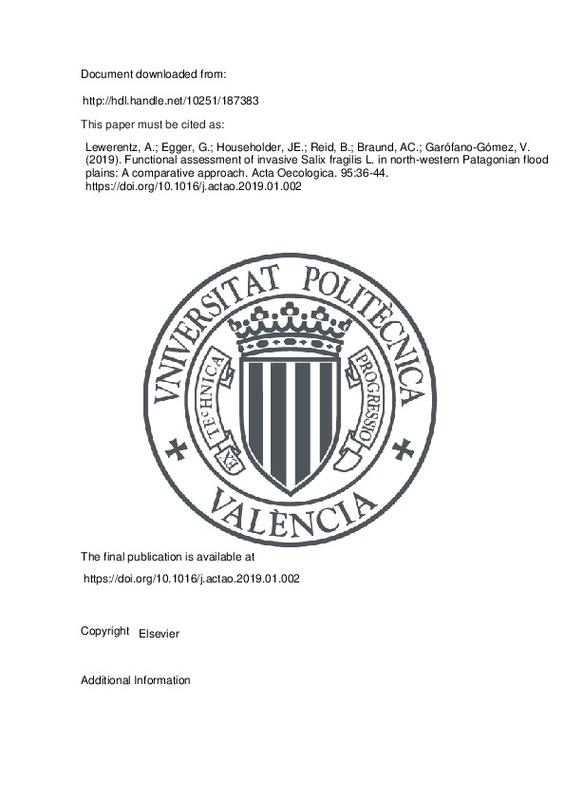JavaScript is disabled for your browser. Some features of this site may not work without it.
Buscar en RiuNet
Listar
Mi cuenta
Estadísticas
Ayuda RiuNet
Admin. UPV
Functional assessment of invasive Salix fragilis L. in north-western Patagonian flood plains: A comparative approach
Mostrar el registro sencillo del ítem
Ficheros en el ítem
| dc.contributor.author | Lewerentz, Anne
|
es_ES |
| dc.contributor.author | Egger, Gregory
|
es_ES |
| dc.contributor.author | Householder, J. Ethan
|
es_ES |
| dc.contributor.author | Reid, Brian
|
es_ES |
| dc.contributor.author | Braund, Andreas Ch
|
es_ES |
| dc.contributor.author | Garófano-Gómez, Virginia
|
es_ES |
| dc.date.accessioned | 2022-10-10T18:07:41Z | |
| dc.date.available | 2022-10-10T18:07:41Z | |
| dc.date.issued | 2019-02 | es_ES |
| dc.identifier.issn | 1146-609X | es_ES |
| dc.identifier.uri | http://hdl.handle.net/10251/187383 | |
| dc.description.abstract | [EN] European willows (Salicaceae) are pioneer species in temperate zone floodplains. The species are considered invasive and introduction can lead to substantial alteration of floodplain vegetation communities and ecosystem functioning. Invasive spread of different Salicaceae have been attributed to differences in flood tolerance, growth and dispersal between it and co-occurring native species, suggesting a comparative approach examining key traits to be a profitable strategy in elucidating and predicting patterns of Salicaceae invasion. Here we study incipient Salix fragilis invasions in Chilean Patagonia on the western slopes of the Andes. Our approach combines vegetation transect data with dendroecological analysis to compare patterns of niche position along the hydrogeomorphic gradient, niche breadth, and growth rate among S. fragilis and co-occurring species. We evaluated these traits because they are thought to be key to species¿ capacity to colonize, survive, grow and reproduce in dynamic floodplain habitats. Transect data showed that relative to the most common native trees and shrubs, S. fragilis has the broadest environmental tolerance along the hydrogeomorphic gradient and has a mean niche position closest to severely disturbed and highly flooded channel margins. Moreover, growth models showed that S. fragilis grows faster relative to native species, especially at juvenile stages. Our data suggest that a unique set of trait values allows S. fragilis to occupy a previously under-occupied and abundantly distributed niche, and will continue to colonize, survive, grow and reproduce in morphodynamically disturbed river margins. This is the first report of invasive S. fragilis in Chile, and we comment on potential impacts to native vegetation communities, soil development and ecosystem function. | es_ES |
| dc.description.sponsorship | We thank to Claudio Meier for his support in Chile, to Alicia Marticorena for plant determination and Alex Fajardo for his constructive comments in an early version of this manuscript. German Academic Exchange Service financially supported the field trip to Patagonia. Virginia Garofano-Gomez had a post-doctoral grant from the Universite Blaise Pascal (now: Universite Clermont Auvergne, Clermont-Ferrand, France). | es_ES |
| dc.language | Inglés | es_ES |
| dc.publisher | Elsevier | es_ES |
| dc.relation.ispartof | Acta Oecologica | es_ES |
| dc.rights | Reconocimiento - No comercial - Sin obra derivada (by-nc-nd) | es_ES |
| dc.subject | Nothofagus antarctica | es_ES |
| dc.subject | Salix fragilis | es_ES |
| dc.subject | Salix euxina | es_ES |
| dc.subject | Patagonian rivers | es_ES |
| dc.subject | Floodplain vegetation | es_ES |
| dc.subject | Vacant niche | es_ES |
| dc.title | Functional assessment of invasive Salix fragilis L. in north-western Patagonian flood plains: A comparative approach | es_ES |
| dc.type | Artículo | es_ES |
| dc.identifier.doi | 10.1016/j.actao.2019.01.002 | es_ES |
| dc.rights.accessRights | Abierto | es_ES |
| dc.contributor.affiliation | Universitat Politècnica de València. Instituto de Investigación para la Gestión Integral de Zonas Costeras - Institut d'Investigació per a la Gestió Integral de Zones Costaneres | es_ES |
| dc.description.bibliographicCitation | Lewerentz, A.; Egger, G.; Householder, JE.; Reid, B.; Braund, AC.; Garófano-Gómez, V. (2019). Functional assessment of invasive Salix fragilis L. in north-western Patagonian flood plains: A comparative approach. Acta Oecologica. 95:36-44. https://doi.org/10.1016/j.actao.2019.01.002 | es_ES |
| dc.description.accrualMethod | S | es_ES |
| dc.relation.publisherversion | https://doi.org/10.1016/j.actao.2019.01.002 | es_ES |
| dc.description.upvformatpinicio | 36 | es_ES |
| dc.description.upvformatpfin | 44 | es_ES |
| dc.type.version | info:eu-repo/semantics/publishedVersion | es_ES |
| dc.description.volume | 95 | es_ES |
| dc.relation.pasarela | S\462086 | es_ES |







![[Cerrado]](/themes/UPV/images/candado.png)

